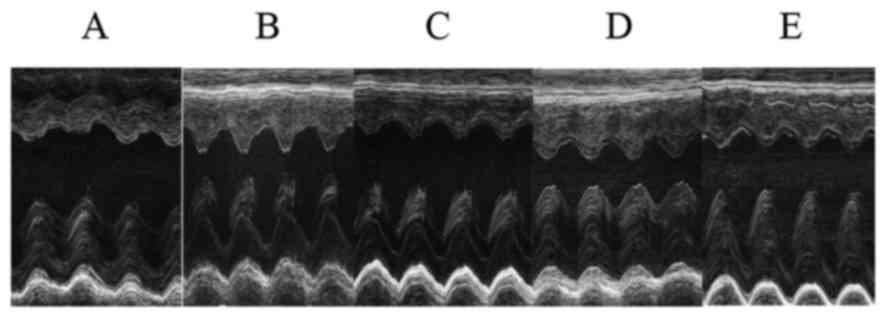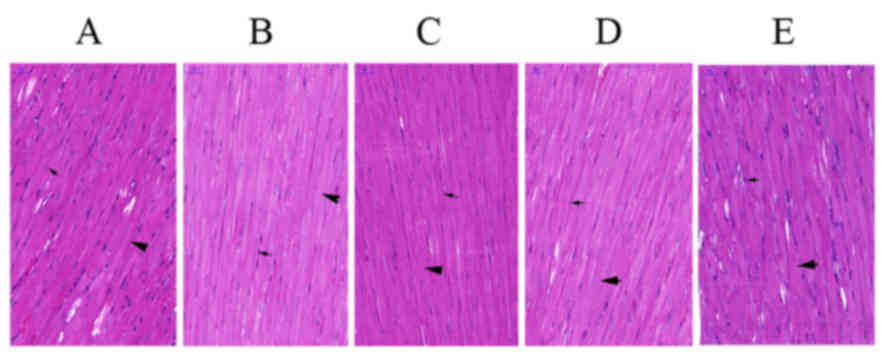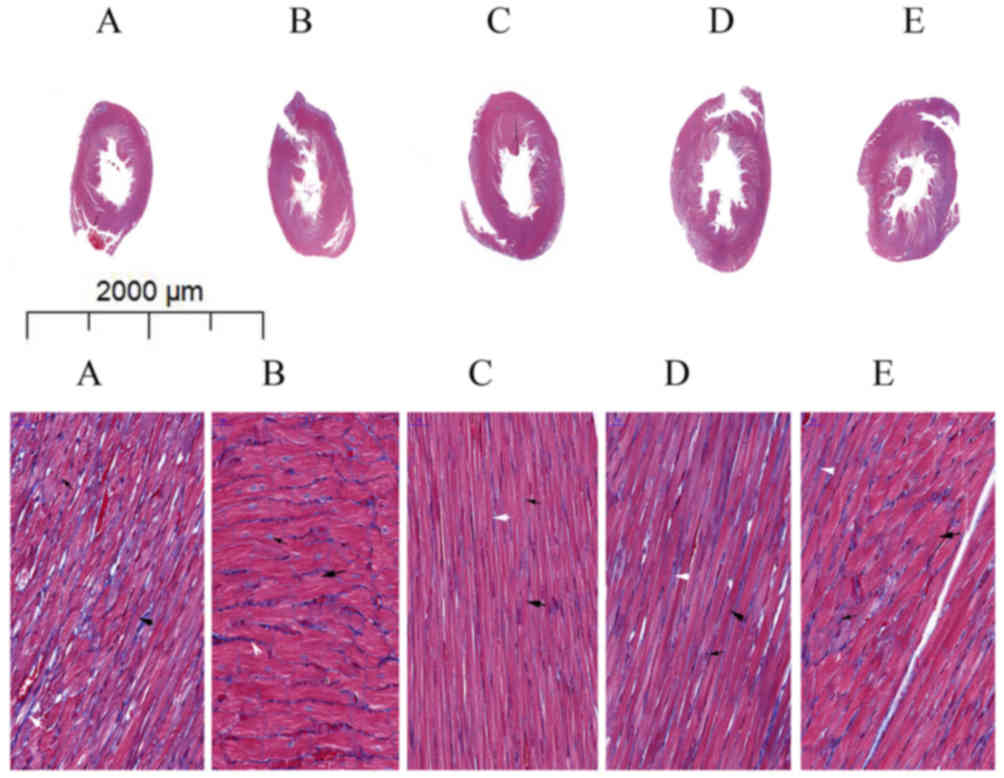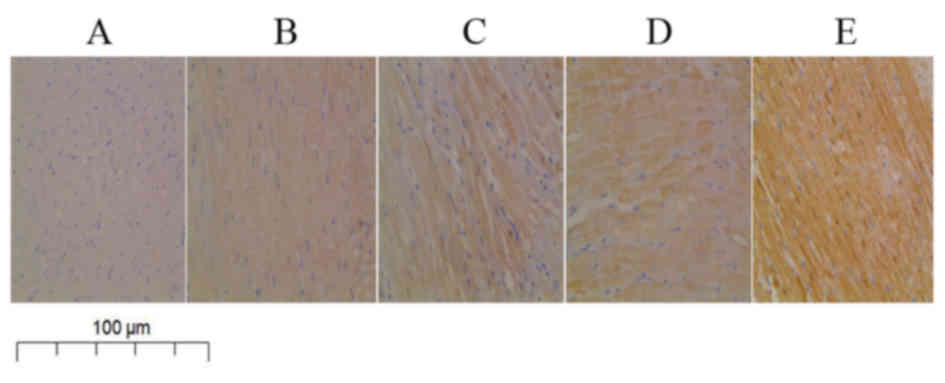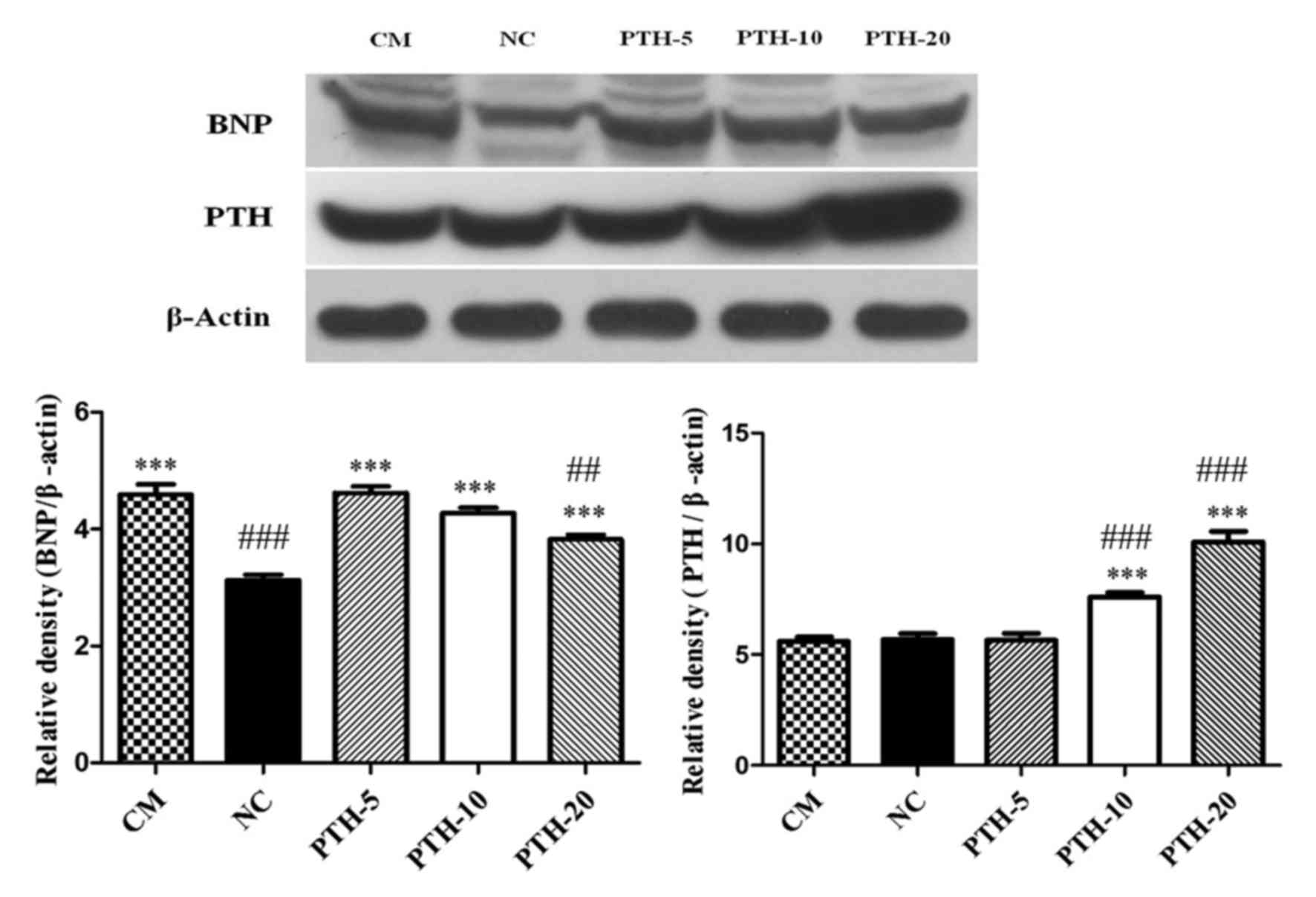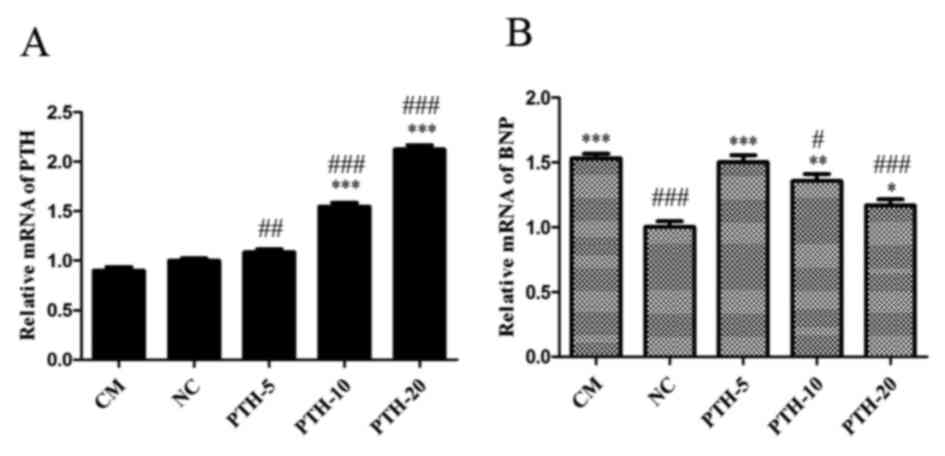Effect of parathyroid hormone on cardiac function in rats with cardiomyopathy
- Authors:
- Published online on: July 26, 2018 https://doi.org/10.3892/etm.2018.6528
- Pages: 2859-2866
-
Copyright: © Wu et al. This is an open access article distributed under the terms of Creative Commons Attribution License.
Abstract
Introduction
Cardiomyopathy (CM) is a common chronic disease that leads to heart failure (HF). Parathyroid hormone (PTH), a 4-amino acid peptide secreted by parathyroid cells, is the major regulator of blood calcium and phosphorus metabolism and regulates the cardiovascular system via the G-protein-coupled parathyroid hormone receptor (1,2). Extensive studies have been performed to investigate the association between PTH and HF, particularly the therapeutic potential of PTH in HF and myocardial injury (3–6). Previous studies have indicated that PTH enhances myocardial contractility and improves cardiac function by influencing the shortening fraction and autorhythmicity (7,8). Additionally, PTH directly dilates the coronary artery and promotes myocardial microcirculation, thereby improving the myocardial oxygen supply and cardiac pump function (9–12). Furthermore, PTH regulates the secretion and expression of stromal derived factor 1, matrix metalloproteinase 9 and granulocyte colony stimulating factor in the bone marrow and induces the mobilization and homing of cluster of differentiation (CD)34/CD45-positive bone marrow stem cells, thereby promoting the release of vascular endothelial growth factor and angiogenesis (13–16). Some studies using animal-model systems have verified that injection of PTH promotes the production of endothelium-derived colony stimulating factor, angiogenesis and cell viability, thereby reducing myocardial necrosis in rats with myocardial infarction (17–20). Therefore, PTH may be applicable as a therapeutic agent for acute myocardial infarction and ischemic CM. However, the potential therapeutic value of PTH for non-ischemic CM has not been determined.
In the present study, a rat model of Adriamycin (ADR)-induced CM was established. Recombinant PTH (rPTH) was administered and its effects on cardiac function and the underlying mechanisms were evaluated. Results from the study provide a theoretical basis for the potential application of PTH as a treatment for non-ischemic CM.
Materials and methods
Animals
A total of 30 Sprague-Dawley rats (age, 12–16 weeks; male; weight, 250 g) were purchased from Nanjing Qingzilan Technology (Nanjing, China) and randomly divided into a normal control (NC) group (n=6) and an experimental group (n=24). The ADR-induced CM in a rat model was established in the experimental group of animals according to the method previously described by Teraoka et al (21). Briefly, at total of 5 injections of 2 mg/kg ADR (Shanghai Dibo Chemical Technology Co., Ltd., Shanghai, China) was administered intraperitoneally every third day for a total of 15 days followed by a further injection every week for 5 weeks, for a total cumulative dose of 20 mg/kg. Age-matched rats in the NC group received intraperitoneal injections of normal saline. The rats were housed at a temperature and humidity of 20–25°C and 40–70%, respectively, with a 12 h light/dark cycle and ad libitum access to food and water. Under these conditions, rat physical activity, food intake, urine-output volume and mental status were monitored. Cardiac ultrasonography and plasma B-type natriuretic peptide (BNP) levels were assessed to confirm the successful establishment of CM. Following a total of 10 weeks, rats in the experimental group were randomly subdivided into the PTH-untreated CM group and three CM treatment groups. In the NC and PTH-untreated CM group, rats received daily mock-treatments for 7 days consisting of subcutaneous injections of normal saline. For the CM treatment groups, CM-induced rats were subdivided into three equal subgroups and received daily subcutaneous injections of rPTH (Rattus norvegicus, Residues Ala32-Gln115; Cloud-Clone Corp., Wuhan, China) at doses of 5, 10 or 20 µg/kg for 7 days. The subgroups were termed PTH-5, PTH-10, and PTH-20, respectively.
The present study was approved by the Animal Care and Use Committee of Anhui Medical University (Wuxi, China) and all animals received care compliant with standards of the Guide for the Care and Use of Laboratory Animals published in 1988 by The National Academies.
Measurement of biochemical indices
A total of 10 weeks following the start of the experiment, blood was collected from the femoral arteries of 5 randomly selected rats from each of the NC and experimental groups and the sera were processed. Concentrations of PTH, BNP, C-reactive protein (CRP), troponin T and electrolytes in the sera were determined prior to the establishment of the five subgroups. At 11 weeks following the start of the experiment, blood samples of rats in the five subgroups were collected again and the sera was analyzed for PTH, BNP, CRP, troponin T and electrolyte concentrations. The levels of PTH (cat. no. E-EL-R0714c), BNP (cat. no. E-EL-R0126c), and troponin T (cat. no. E-EL-R0054c) were determined using the appropriate rat ELISA kits (Wuhan Elabscience Biotechnology Co., Ltd., Wuhan, China). The biochemical indices were determined using an automated biochemical analyzer (AU480; Beckman Coulter, Inc., Brea, CA, USA).
Cardiac ultrasonography
Following 10 weeks of starting of the experiments, prior to the establishment of the five subgroups, 5 randomly selected rats from each of the NC and experimental groups were evaluated using a high-resolution ultrasound system for small animal imaging (Vevo 2100; VisualSonics Inc., Toronto, ON, Canada). Ultrasonic determination of the left atrial diameter, interventricular septal thickness, left ventricular end-diastolic volume (LVEDV), left ventricular end-systolic volume (LVESV), left ventricular fractional shortening (LVFS) and left ventricular ejection fraction (LVEF) was performed for each rat analyzed. Cardiac ultrasonography was performed again at week 11.
Preparation of samples
At the end of the experiments, the rats were sacrificed by cervical dislocation and the hearts were harvested for paraffin-embedded sectioning and histological analyses. In brief, 10% formalin-fixed (4°C, ~48 h) and paraffin-embedded heart tissues were transversely cut into 4-µm thick sections. Immunohistochemical staining of PTH on the tissue sections was performed at room temperature for 200–240 min with assistance from personnel from the Department of Pathology at the Third People's Hospital of Zhenjiang (Zhenjiang, China). PTH expression was observed and photographed under an optical microscope (cat. no. CX41-32C02; Olympus Corporation, Tokyo, Japan; magnification, ×40-400). Hematoxylin and eosin (HE) staining (cat. no. G1005) and Masson's trichome staining (cat. no. G1006) of paraffin sections were performed using kits (Wuhan Goodbio Technology Co., Ltd. Wuhan, China). HE staining was performed at room temperature for ~120 min and Masson's trichome staining was performed at room temperature for ~130 min. Pictures were obtained using a digital slice scanning analysis system (Pannoramic P250; 3DHISTECH Ltd., Budapest, Hungary).
Furthermore, western blot analysis was also performed to detect the protein expression of PTH in the myocardial tissues. Total cell lysates for western blot analysis were prepared using radioimmunoprecipitation assay lysis buffer (pH=8.0; 150 mM NaCl, 0.5% sodium deoxycholate, 1.0% Triton x-100, 50 mM Tris, and 0.1% SDS). Protein concentrations were measured using a BCA Protein Assay Kit (Thermo Scientific, Inc.). Cell lysates containing 20 µg of protein were boiled for 10 min in sample loading buffer mixed with reducing reagent (Thermo Fisher Scientific, Inc.) prior to separation by SDS-PAGE. The protein samples were electrophoretically separated on NuPAGE Novex 10% Bis-Tris gels commercially available from Thermo Fisher Scientific, Inc. and then transferred to polyvinylidene fluoride membranes (EMD Millipore, Billerica, MA, USA). The membrane blots were blocked in 5% non-fat dry milk in 0.05% PBST at room temperature for 1 h, and incubated with the anti-PTH polyclonal antibody (Cloud-Clone Corp.; cat. no. Ala32-Gln115; 1:1,000) at 4°C for 2 h. After washing with 0.05% PBST, membranes were then incubated with the horseradish peroxidase conjugated-anti-Rabbit secondary antibody (Jackson ImmunoResearch Europe Ltd.,. Cambridgeshire, UK; cat. no. 111-035-003; 1:5,000) at room temperature for 1 h. Western blots were then developed using an ECL reagent (Merck KGaA, Darmstadt, Germany) and detected using a Tanon 5200 Multi System (Tanon Science and Technology Co., Ltd., Shanghai, China). The housekeeping β-actin gene was used as a control reference gene.
The mRNA expression levels of PTH and BNP were measured using RT-qPCR. Briefly, total RNA was extracted using TRIzol (Thermo Fisher Scientific., Inc.) and the cDNA was synthesized using a First-Strand cDNA Synthesis Kit (Thermo Fisher Scientific, Inc.). PCR mixtures contained 10 µl SYBR Green I (Takara Bio Inc., Otsu, Japan), 0.2 µM sense primer, 0.2 µM antisense primer, 2 µl cDNA and 7.6 µl H2O in a total volume of 20 µl. Primers are indicated in Table I. The primers were synthesized by Shanghai Rui Mian Biological Technology Co., Ltd. (Shanghai, China). GAPDH was used as an internal control reference gene.
Statistical analysis
All statistical analyses were performed using SPSS software version 16.0 (SPSS, Inc., Chicago, IL, USA). Quantitative data are presented as mean ± standard deviation. To compare the differences between the groups, one-way analysis of variance (ANOVA) and least significant difference post hoc tests were applied. P<0.05 was considered to indicate a statistically significant difference.
Results
Induction of the CM model using ADR and the preparation of samples
During establishment of ADR-induced CM, 2 rats from the experimental group died; no rats from the control group died. At 10 weeks following the start of the experiments, 15 of the surviving rats from the experimental group were randomly selected and equally divided into three treatment subgroups (n=5/treatment group) and termed PTH-5, PTH-10 and PTH-20, respectively. The remaining 7 rats were placed into the PTH-untreated CM group. Following completion of the treatment regimen, myocardial tissue samples were collected from 5 rats of the NC group, PTH-untreated CM group and the three PTH-5, PTH-10, and PTH-20 groups (n=25 total).
Changes in rat biochemistry upon CM induction using ADR
The serum concentrations of BNP, troponin T, CRP, creatinine and phosphorus were all increased in the rats with ADR-induced CM compared with those concentrations in the NC group; however, the serum concentrations of PTH and calcium were decreased in the rats with ADR-induced CM compared with those concentrations in the NC group (data not shown). Notably, compared with CM group, the administration of PTH decreased the serum levels of BNP, CRP, troponin T, creatinine and phosphorus and increased the serum levels of PTH and calcium in a dose-dependent manner. ANOVA results indicated that the overall differences for these biochemistry indexes among the five experimental groups all reached statistical significance (P<0.01; Table II).
Cardiac ultrasonography
The LVEF and LVFS were markedly decreased and the LVESV was significantly increased in the CM group compared with that in the NC group (P<0.01). The LVEF and LVFS were gradually resolved with increasing doses of PTH, whereas the LVESV exhibited no consistent change with PTH treatment. The differences of the LVEF, LVFS and LVESV among the five groups reached statistical significance (P<0.01). There were trends for dose-dependent increases in LV mass and LVEDV with PTH-treatment, but these differences failed to reach statistical significance (P>0.05). The details of the findings are indicated in Table II and Fig. 1.
Changes in myocardial tissue morphology of rats
Results from HE staining of heart tissue specimens from the experimental rats revealed that myocardial fibers (indicated by a bold black arrow; Fig. 2A) were disordered and the distribution density of myocardial nuclei (indicated by a thin black arrow; Fig. 2A) was increased in the PTH-untreated CM group (Fig. 2A) compared with those in the NC group (Fig. 2B). Administration of rPTH caused the myocardial permutation to become regular and the distribution density of myocardial nuclei was decreased (Fig. 2C-E). As indicated in Masson's trichome staining of heart tissue specimens from the experimental rats, myocardial fibers (indicated by a bold black arrow; Fig. 3A) were thinner and disordered in the PTH-untreated CM group (Fig. 3A) compared with those in the NC group (Fig. 3B), whereas the number of collagen fibers (indicated by a white arrow; Fig. 3A) had increased. Administration of rPTH in a dose-dependent manner resulted in thicker, regular myocardial fibers (Fig. 3C-E).
Changes in expression levels of PTH protein and mRNA in myocardial tissue
Results from immunohistochemical analysis of heart tissue specimens from the experimental rats revealed that the expression of PTH protein in the cytoplasm of myocardial cells was markedly decreased in the PTH-untreated CM group compared with that in the NC group (Fig. 4A and B). Furthermore, administration of rPTH enhanced the expression of PTH protein in a dose-dependent manner (Fig. 4C-E). Consistent with the immunohistochemistry results, western blot analysis also demonstrated that the expression levels PTH protein in the myocardial tissue of the PTH-untreated CM group was slightly lower compared with the levels expressed in the NC control group (P>0.05). Additionally, 10 and 20 µg/kg PTH treatment in rats with ADR-induced CM significantly increased the expression levels of PTH protein (all P<0.001 vs. NC group and CM group). However, the PTH protein expression levels in the PTH-5 group compared with the PTH-untreated CM group and the NC group failed to reach a statistically significant difference (P>0.05; Fig. 5).
Consistent with the detected protein expression levels, the PTH mRNA expression levels in the myocardial tissue were decreased in the PTH-untreated CM group compared with the NC group (P>0.05). However, compared with the NC group and the CM group, treatment with rPTH in the PTH-10 and PTH-20 groups significantly elevated the expression levels of PTH mRNA (all P<0.001). The levels of PTH mRNA in the PTH-5 group were also significantly elevated compared with the CM group (P<0.01), while only slightly elevated compared with the NC group. The results are presented in Fig. 6A.
Changes in the expression levels of BNP protein and mRNA in myocardial tissue
Western blot analysis of cell lysates generated from heart tissue from the experimental rats demonstrated that BNP protein expression in myocardial tissue was significantly increased in the PTH-untreated CM group compared with that in the NC group (P<0.001), and rPTH treatment in ADR-induced CM rats gradually decreased the expression levels of BNP protein in a dose-dependent manner (all P<0.001 vs. NC group). However, compared with the CM group, treatment with rPTH only in the PTH-20 group significantly decreased the expression levels of BNP protein (P<0.01; Fig. 5).
Notably, the expression levels of BNP mRNA in myocardial tissue were also significantly increased in the PTH-untreated CM group compared with the NC group (P<0.001). Furthermore, consistent with the indicated protein expression levels, rPTH treatment decreased the BNP mRNA expression levels in a dose-dependent manner (P<0.001, P<0.01 and P<0.05 vs. NC group, respectively). However, compared with the CM group, the expression of BNP mRNA in the PTH-10 and PTH-20 groups were significantly decreased (P<0.05 and P<0.001, respectively), while those in the PTH-5 group were only slightly decreased. The results were presented in Fig. 6B.
Discussion
In the present study, an ADR-induced CM rat model was established to observe the effects of PTH on myocardial pathology and cardiac function. Results indicated that ADR treatment increased serum levels of BNP and decreased LVEF, which suggested the successful establishment of CM in the animal model. Conversely, treatment with rPTH significantly decreased serum BNP, and cardiac ultrasonography indicated that the rPTH decreased the LVESV and enhanced the LVEF, suggesting improved overall cardiac function in rats with ADR-induced CM. PTH exerts direct hypertrophic effects on myocardium (22). In the present study, HE staining of paraffin sections revealed that the distribution density of the myocardial nuclei of rats in PTH-treated CM groups was decreased compared with the PTH-untreated CM rats, which may be explained by the thickening of the myocardial fibers. Masson's trichome staining of paraffin sections further confirmed that myocardial fibers of rats in the PTH-treated CM groups were thicker and more regular compared with those of the PTH-untreated CM rats. These results were consistent with those of a previous study (22). Notably, there were consistent trends for dose-dependent increases in LV mass following PTH-treatment, although these differences did not reach statistical significance. The short observation time and small sample size may have contributed to the lack of detectable statistically significant differences. In addition, immunohistochemistry and western blot analysis revealed that the expression of PTH protein in myocardial tissue was significantly elevated following PTH treatment, suggesting that PTH acted on myocardial tissue to improve the myocardial remodeling and cardiac function in non-ischemic CM. Furthermore, the expression of BNP protein in myocardial tissue of the PTH-untreated CM group was significantly elevated, and treatment with rPTH decreased the expression of BNP in a dose-dependent manner, further suggesting that PTH could improve cardiac function in non-ischemic CM. Therefore, results from the present study effectively supported the protective effect of PTH on ischemic CM in rats. Interestingly, the present data suggested that 20 µg/kg/day as a treatment dose produced a positive therapeutic effect. Notably, this dose was lower than the typical dose, which was used in a previous myocardial infarction study in rats (20).
PTH influences myocardium and cardiac function via expansion of blood vessels to decrease peripheral resistance, positive inotropic action and reduction of left ventricle thickness and volume to improve ventricular remodeling (19). In addition, PTH activates PTH 1 receptor on smooth muscle cells to increase cyclic AMP synthesis, which reduces calcium influx and leads to the expansion of blood vessels (12,23). This expansion subsequently decreases cardiac load and improves cardiac pump function (4). Additionally, PTH enhances myocardial contractility through the activation of voltage-dependent calcium channel-dependent calcium influx (24,25), elevating the autorhythmicity of the sinoatrial node and the heart rate. In the present study, cardiac ultrasonography indicated that PTH significantly reduced the LVESV of rats, suggesting an inhibitory role for PTH in ventricular remodeling. Such effects may be associated with the persistent expansion of peripheral vessels, decreased arterial elasticity and subsequent reduced peripheral resistance (26,27). Conversely, PTH interacts with adrenergic signals mediated by G-protein coupled receptor kinases, including β-adrenoreceptor kinase, which can influence ventricular remodeling (5,28). As PTH has multiple targets of action, namely smooth muscle and the myocardium, it may improve cardiac function by decreasing the cardiac load, enhancing myocardial contractility and inhibiting the nervous system (29). Because of this diversity, PTH has pronounced therapeutic potential for treating HF resulting from various causes.
Currently, PTH is primarily used in the treatment of patients with osteoporosis (30). Further investigation into the role of PTH in CM and HF is required. The present study revealed that PTH was predominantly expressed in the cytoplasm of myocardial cells; however, the specific signaling pathways in myocardial cells that may be involved and the potential interaction of PTH with organelles also requires further study.
One of the limitations of the current study was the small sample size. Secondly, only 5 rats from each group were randomly selected for the collection of blood samples and used for cardiac ultrasonography analysis rather than all of the rats, which may have resulted in less exacting conclusions. Thirdly, the data collected were simplified; more objective indicators of cardiac function, such as left ventricular filling pressure, were not analyzed. Therefore, the primary endpoints of the present study were relatively simplistic. As mentioned above, further studies should be conducted to identify the specific signaling pathways on which PTH interacts with in myocardial cells.
In conclusion, the present findings demonstrated that PTH improved the cardiac function in rats with ADR-induced CM by affecting myocardial contractility and remodeling. These findings provide promise for the development of a PTH-based clinical treatment of non-ischemic CM.
Acknowledgements
Not applicable.
Funding
The present study was supported by the Scientific Research Project of the Wuxi Municipal Health and Family Planning Commission (grant nos. MS201638 and Z201608).
Availability of data and materials
The datasets used and/or analyzed during the current study are available from the corresponding author on reasonable request.
Authors' contributions
GW and GZ conceived and designed the current study. GW, TW, BX, YS, XZ and XW performed the experiments. GW, TW, BX and YS performed data analysis. GW drafted the manuscript and ZC created the figures and was involved in data analysis. All authors read and approved the final manuscript.
Ethics approval and consent to participate
The present study was approved by the Animal Care and Use Committee of Anhui Medical University (Wuxi, China) and all animals received care compliant with standards of the Guide for the Care and Use of Laboratory Animals published in 1988 by The National Academies.
Patient consent for publication
Not applicable.
Competing interests
The authors declare that they have no competing interests.
References
|
Wu G, Wang X, Wang X, Jiang H, Wang L, Wang T, Liu J, An D, Cao L, Xia Y and Zong G: Serum parathyroid hormone levels predict discharge and readmission for heart failure. Genet Test Mol Biomarkers. 20:328–334. 2016. View Article : Google Scholar : PubMed/NCBI | |
|
Altay H and Colkesen Y: Parathyroid hormone and heart failure: Novel biomarker strategy. Endocr Metab Immune Disord Drug Targets. 13:100–104. 2013. View Article : Google Scholar : PubMed/NCBI | |
|
Kubiak GM, Kolaszko A and Nowalany-Kozielska E: Parathyroid hormone serum concentration in Central European patients with non-ischemic heart failure as a potential marker of disease severity and poor prognosis. Endokrynol Pol. 68:299–305. 2017. View Article : Google Scholar : PubMed/NCBI | |
|
Ballane GT, Sfeir JG, Dakik HA, Brown EM and El-Hajj Fuleihan G: Use of recombinant human parathyroid hormone in hypocalcemic cardiomyopathy. Eur J Endocrinol. 166:1113–1120. 2012. View Article : Google Scholar : PubMed/NCBI | |
|
Qian J, Colbert MC, Witte D, Kuan CY, Gruenstein E, Osinka H, Lanske B, Kronenberg HM and Clemens TL: Midgestational lethality in mice lacking the Parathyroid hormone (PTH)/PTH-related peptide receptor is associated with abrupt cardiomyocyte death. Endocrinology. 144:1053–1061. 2003. View Article : Google Scholar : PubMed/NCBI | |
|
Monego G, Arena V, Pasquini S, Stigliano E, Fiaccavento R, Leone O, Arpesella G, Potena L, Ranelletti FO, Di Nardo P and Capelli A: Ischemic injury activates PTHrP and PTH1R expression in human ventricular cardiomyocytes. Basic Res Cardiol. 104:427–434. 2009. View Article : Google Scholar : PubMed/NCBI | |
|
Zittermann A, Ernst JB, Pilz S, Dreier J, Kuhn J, Knabbe C, Gummert JF, Morshuis M and Milting H: Calciotropic and phosphaturic hormones in end-stage heart failure patients supported by a left-ventricular assist device. PLoS One. 11:e01644592016. View Article : Google Scholar : PubMed/NCBI | |
|
Choi YH, Cowan DB, Wahlers TC, Hetzer R, Del Nido PJ and Stamm C: Calcium sensitisation impairs diastolic relaxation in post-ischaemic myocardium: Implications for the use of Ca(2+) sensitising inotropes after cardiac surgery. Eur J Cardiothorac Surg. 37:376–383. 2010.PubMed/NCBI | |
|
Osto E, Fallo F, Pelizzo MR, Maddalozzo A, Sorgato N, Corbetti F, Montisci R, Famoso G, Bellu R, Lüscher TF, et al: Coronary microvascular dysfunction induced by primary hyperparathyroidism is restored after parathyroidectomy. Circulation. 126:1031–1039. 2012. View Article : Google Scholar : PubMed/NCBI | |
|
Capitanio S, Sambuceti G, Giusti M, Morbelli S, Murialdo G, Garibotto G, Vera L, Ameri P, Repetto B, Naseri M, et al: 1,25-Dihydroxy vitamin D and coronary microvascular function. Eur J Nucl Med Mol Imaging. 40:280–289. 2013. View Article : Google Scholar : PubMed/NCBI | |
|
Verdoia M, Pergolini P, Rolla R, Nardin M, Barbieri L, Schaffer A, Bellomo G, Marino P, Suryapranata H and De Luca G: Novara Atherosclerosis Study Group (NAS): Parathyroid hormone levels and high-residual platelet reactivity in patients receiving dual antiplatelet therapy with acetylsalicylic acid and clopidogrel or ticagrelor. Cardiovasc Ther. 34:209–215. 2016. View Article : Google Scholar : PubMed/NCBI | |
|
Schreckenberg R, Wenzel S, da Costa Rebelo RM, Röthig A, Meyer R and Schlüter KD: Cell-specific effects of nitric oxide deficiency on parathyroid hormone-related peptide (PTHrP) responsiveness and PTH1 receptor expression in cardiovascular cells. Endocrinology. 150:3735–3741. 2009. View Article : Google Scholar : PubMed/NCBI | |
|
Wang LL, Chen D, Lee J, Gu X, Alaaeddine G, Li J, Wei L and Yu SP: Mobilization of endogenous bone marrow derived endothelial progenitor cells and therapeutic potential of parathyroid hormone after ischemic stroke in mice. PLoS One. 9:e872842014. View Article : Google Scholar : PubMed/NCBI | |
|
Wang ST, Gao YJ, Duan CC, Li DD, Tian XC, Zhang QL, Guo B and Yue ZP: Effects of PTHrP on expression of MMP9 and MMP13 in sika deer antler chondrocytes. Cell Biol Int. 37:1300–1307. 2013. View Article : Google Scholar : PubMed/NCBI | |
|
Li S, Zou D, Li C, Meng H, Sui W, Feng S, Cheng T, Zhai Q and Qiu L: Targeting stem cell niche can protect hematopoietic stem cells from chemotherapy and G-CSF treatment. Stem Cell Res Ther. 6:1752015. View Article : Google Scholar : PubMed/NCBI | |
|
Cusano NE, Rubin MR, Zhang C, Anderson L, Levy E, Costa AG, Irani D and Bilezikian JP: Parathyroid hormone 1–84 alters circulating vascular endothelial growth factor levels in hypoparathyroidism. J Clin Endocrinol Metab. 99:E2025–E2028. 2014. View Article : Google Scholar : PubMed/NCBI | |
|
Engelmann MG, Theiss HD, Hennig-Theiss C, Huber A, Wintersperger BJ, Werle-Ruedinger AE, Schoenberg SO, Steinbeck G and Franz WM: Autologous bone marrow stem cell mobilization induced by granulocyte colony-stimulating factor after subacute ST-segment elevation myocardial infarction undergoing late revascularization: Final results from the G-CSF-STEMI (Granulocyte Colony-Stimulating Factor ST-Segment Elevation Myocardial Infarction) trial. J Am Coll Cardiol. 48:1712–1721. 2006. View Article : Google Scholar : PubMed/NCBI | |
|
Zohlnhöfer D, Ott I, Mehilli J, Schömig K, Michalk F, Ibrahim T, Meisetschläger G, von Wedel J, Bollwein H, Seyfarth M, et al: Stem cell mobilization by granulocyte colony-stimulating factor in patients with acute myocardial infarction: A randomized controlled trial. JAMA. 295:1003–1010. 2006. View Article : Google Scholar : PubMed/NCBI | |
|
Zaruba MM, Huber BC, Brunner S, Deindl E, David R, Fischer R, Assmann G, Herbach N, Grundmann S, Wanke R, et al: Parathyroid hormone treatment after myocardial infarction promotes cardiac repair by enhanced neovascularization and cell survival. Cardiovasc Res. 77:722–731. 2008. View Article : Google Scholar : PubMed/NCBI | |
|
Brunner S, Weinberger T, Huber BC, Segeth A, Zaruba MM, Theiss HD, Assmann G, Herbach N, Wanke R, Mueller-Hoecker J and Franz WM: The cardioprotective effects of parathyroid hormone are independent of endogenous granulocyte-colony stimulating factor release. Cardiovasc Res. 93:330–339. 2012. View Article : Google Scholar : PubMed/NCBI | |
|
Teraoka K, Hirano M, Yamaguchi K and Yamashina A: Progressive cardiac dysfunction in adriamycin-induced cardiomyopathy rats. Eur J Heart Fail. 2:373–378. 2000. View Article : Google Scholar : PubMed/NCBI | |
|
Schlüter KD and Piper HM: Cardiovascular actions of parathyroid hormone and parathyroid hormone-related peptide. Cardiovasc Res. 37:34–41. 1998. View Article : Google Scholar : PubMed/NCBI | |
|
Noda M, Katoh T, Takuwa N, Kumada M, Kurokawa K and Takuwa Y: Synergistic stimulation of parathyroid hormone-related peptide gene expression by mechanical stretch and angiotensin II in rat aortic smooth muscle cells. J Biol Chem. 269:17911–17917. 1994.PubMed/NCBI | |
|
Wu P, Xie F, Xue M, Xu X, He S, Lin M and Bai L: Advanced oxidation protein products decrease the expression of calcium transport channels in small intestinal epithelium via the p44/42 MAPK signaling pathway. Eur J Cell Biol. 94:190–203. 2015. View Article : Google Scholar : PubMed/NCBI | |
|
Selim AA, Mahon M, Juppner H, Bringhurst FR and Divieti P: Role of calcium channels in carboxyl-terminal parathyroid hormone receptor signaling. Am J Physiol Cell Physiol. 291:C114–C121. 2006. View Article : Google Scholar : PubMed/NCBI | |
|
Hagström E, Ahlström T, Ärnlöv J, Larsson A, Melhus H, Hellman P and Lind L: Parathyroid hormone and calcium are independently associated with subclinical vascular disease in a community-based cohort. Atherosclerosis. 238:420–426. 2015. View Article : Google Scholar : PubMed/NCBI | |
|
Rocha-Singh KJ, Zeller T and Jaff MR: Peripheral arterial calcification: Prevalence, mechanism, detection, and clinical implications. Catheter Cardiovasc Interv. 83:E212–E220. 2014. View Article : Google Scholar : PubMed/NCBI | |
|
Seeland U, Selejan S, Engelhardt S, Müller P, Lohse MJ and Böhm M: Interstitial remodeling in beta1-adrenergic receptor transgenic mice. Basic Res Cardiol. 102:183–193. 2007. View Article : Google Scholar : PubMed/NCBI | |
|
Hong ZR, Gil HW, Yang JO, Lee EY, Ahn JO and Hong SY: Associations between sympathetic activity, plasma concentrations of renin, aldosterone, and parathyroid hormone, and the degree of intractability of blood pressure control in modialysis patients. J Korean Med Sci. 22:604–610. 2007. View Article : Google Scholar : PubMed/NCBI | |
|
Cheng ZY, Ye T, Ling QY, Wu T, Wu GY and Zong GJ: Parathyroid hormone promotes osteoblastic differentiation of endothelial cells via the extracellular signal-regulated protein kinase 1/2 and nuclear factor-κB signaling pathways. Exp Ther Med. 15:1754–1760. 2018.PubMed/NCBI |



